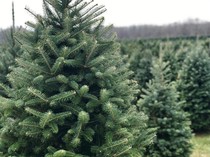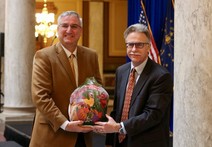10 Tips to Take Care of Your Tree
Growing Christmas trees is hard work. They require constant care, the right environment and can take up to 15 years to reach the proper height. Each year, growers overcome every obstacle so that families across the U.S. can continue their time-honored tradition of picking the right Christmas tree.
For most, the holiday season doesn’t officially begin until the tree is up and decorated, but like the growing season, caring for a tree once it’s up also requires proper care and attention. In order to maintain the quality of your tree this year, here are 10 helpful tips provided by the National Christmas Tree Association.
 1. Displaying trees in water in a traditional reservoir type stand is the most effective way of maintaining their freshness and minimizing needle loss problems.
2. To display the trees indoors, use a stand with an adequate water holding capacity for the tree. As a general rule, stands should provide 1 quart of water per inch of stem diameter.Devices are available that help maintain a constant water level in the stand.
3. Use a stand that fits your tree. Avoid whittling the sides of the trunk down to fit a stand. The outer layers of wood are the most efficient in taking up water and should not be removed.
4. Make a fresh cut to remove about a 1/2-inch thick disk of wood from the base of the trunk before putting the tree in the stand. Make the cut perpendicular to the stem axis. Don't cut the trunk at an angle, or into a v-shape, which makes it far more difficult to hold the tree in the stand and also reduces the amount of water available to the tree.
5. Drilling a hole in the base of the trunk does NOT improve water uptake.
|
 6. Once home, place the tree in water as soon as possible. Most species can go 6 to 8 hours after cutting the trunk and still take up water. Don't bruise the cut surface or get it dirty. If needed, trees can be temporarily stored for several days in a cool location. Place the freshly cut trunk in a bucket that is kept full of water.
7. Check the stand daily to make sure that the level of water does not go below the base of the tree. With many stands, there can still be water in the stand even though the base of the tree is no longer submerged in water.
8. Keep trees away from major sources of heat (fireplaces, heaters, heat vents, direct sunlight). Lowering the room temperature will slow the drying process, resulting in less water consumption each day.
9. Use of lights that produce low heat, such as miniature lights, will reduce drying of the tree. Always inspect light sets prior to placing them on the tree. If worn, replace with a new set. Do not overload electrical circuits. Always turn off the tree lights when leaving the house or when going to bed.
10. Monitor the tree for freshness. After Christmas or if the tree is very dry, remove it from the house. Never burn any part of a Christmas tree in a wood stove or fireplace. Visit the Tree Recycling page to find a recycling program near you.
ISDA would like to give a special thanks to Saymol’s Tree Farm of Fortville, as well as the Indiana Christmas Tree Growers Association, for donating fresh, Indiana-grown trees every year to the state! Visit www.indianachristmastree.com to learn more or find a tree farm near you!
|

Indiana Farmers: Leaders in Agriculture and Giving Back
Indiana is an agricultural leader. We rank as one of the top states in the nation in many commodities, including duck, hardwoods, hogs, turkeys, corn, soybeans and more. However, one area Indiana’s agricultural community excels at, but very rarely receives recognition for, is giving back to the community, especially during the holidays.
This was apparent during the 71st Indiana State Poultry Association’s annual poultry donation. Governor Eric Holcomb and Indiana State Department of Agriculture Director Bruce Kettler recognized the generosity of Indiana’s poultry producers, who donated more than 75 tons, or 150,000 pounds, of poultry products to families in need in 2018.
That’s comparable to the weight of an average water tower.
 For decades, Indiana’s poultry producers have been working to address food insecurity in their communities by providing protein to food banks across the state. Some of the main products that were donated this year include eggs, chicken, duck and turkey. In fact, more than 600,000 eggs were donated by members of the association, according to Paul Brennan, ISPA Executive Vice President. This was made possible only by the generosity of these producers, as well as the strength of Indiana’s poultry sector, which was also recognized during the ceremony.
According to the USDA National Agricultural Statistics Service, Indiana ranks No. 1 in duck production, No. 2 in egg production and No. 3 in turkeys raised. Annually, the poultry sector contributes more than $9.5 billion to the state’s economy and accounts for more than 11,000 Hoosier jobs.
ISDA would like to thank Indiana’s poultry producers, as well as the other farmers and farm organizations in the state, for supporting so many Hoosiers and families in need.
Visit www.inpoultry.com to learn more about the Indiana State Poultry Association.
|
|